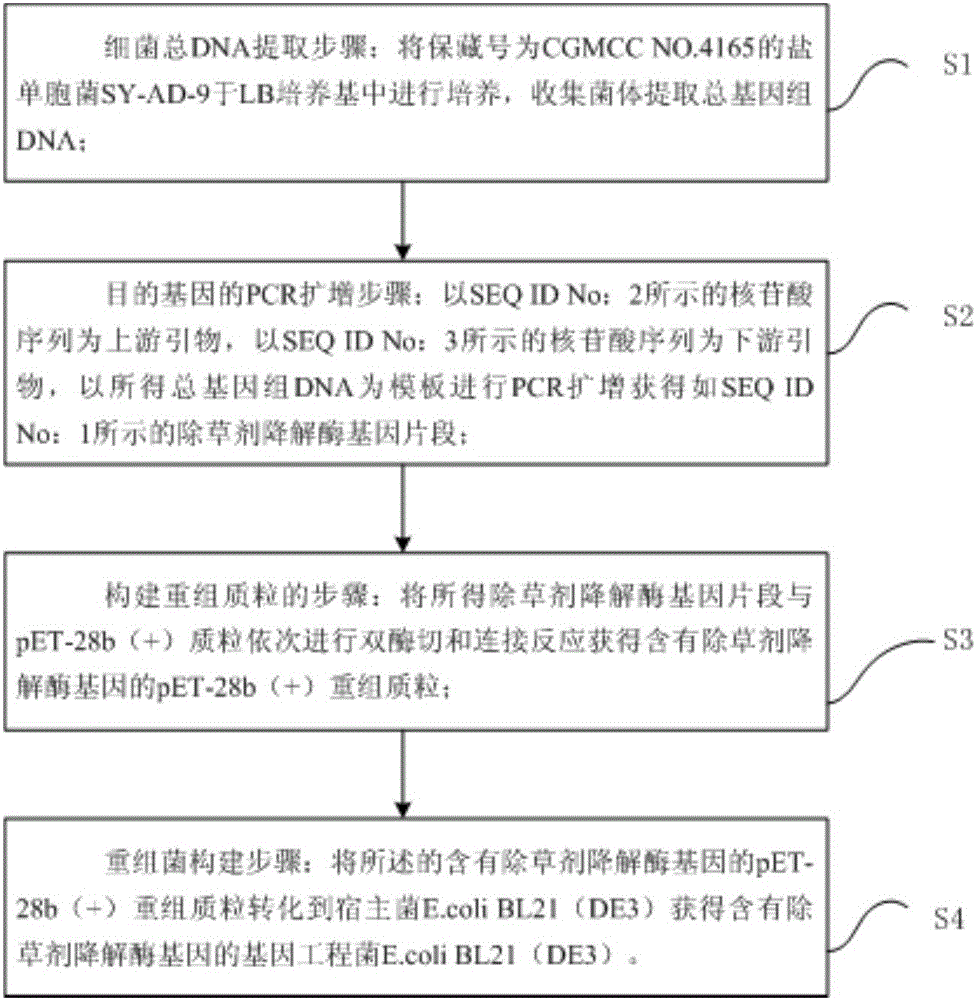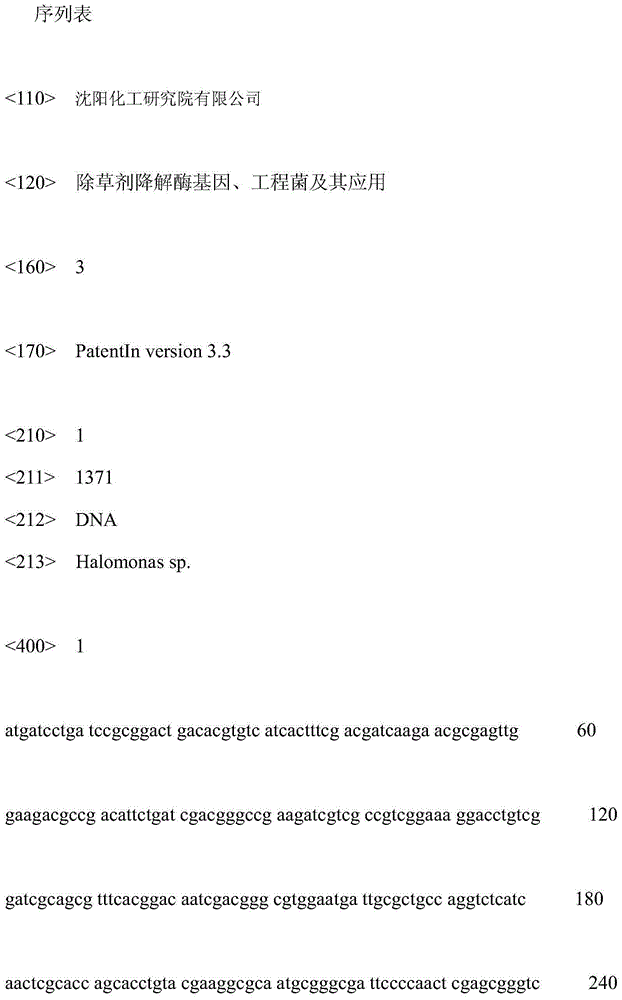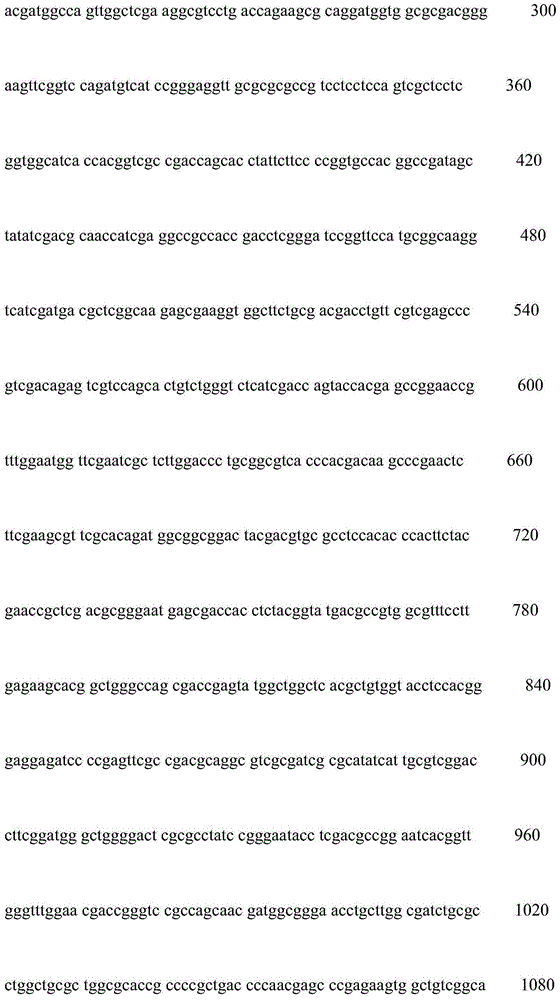Herbicide degrading enzyme gene, engineering bacterium and application of engineering bacterium
A technology of genetically engineered bacteria and degrading enzymes, applied in the field of genetic engineering, can solve problems such as soil, groundwater and surface water pollution
- Summary
- Abstract
- Description
- Claims
- Application Information
AI Technical Summary
Problems solved by technology
Method used
Image
Examples
Embodiment 1
[0036] Amplification and Purification of trzN Gene DNA Fragment
[0037] The first step, bacterial total DNA extraction:
[0038] Genomic DNA of Halomonas sp.SY-AD-9 strain was extracted with Tiangen Genome Extraction Kit, which was used as a template for PCR amplification.
[0039] The second step, trzN gene DNA fragment amplification:
[0040]Upstream primer: 5'-GGAATTCCATATGATCCTGATCCGCG-3' (SEQ ID NO.2 in the sequence listing), which contains a restriction endonuclease NdeI enzyme cutting site (CATATG); downstream primer: 5'-CCCAAGCTTCTACAAGTTCTTGGGA-3' (sequence listing Middle SEQIDNO.3), which contains the restriction endonuclease HindIII enzyme cutting site (AAGCTT), primers were synthesized by Shanghai Sangon Bioengineering Co., Ltd. Using the genomic DNA of the Halomonas sp.SY-AD-9 strain as a template, the above primers were used for PCR amplification. The reaction conditions for the amplification were: pre-denaturation at 95°C for 10 minutes, then denaturation a...
Embodiment 2
[0054] Construction and Identification of Prokaryotic Expression Vector pET-28b(+)-trzN
[0055] The purified PCR product and the pET-28b(+) vector were double-digested with NdeI and HindIII (all restriction enzymes were purchased from NEB Company) respectively, and the purified digested product was recovered with the agarose DNA kit of TIANGEN Company , then carry out cohesive end connection to the PCR product after enzyme digestion and the pET-28b (+) carrier after enzyme digestion, and then use the trzN gene DNA fragment cloning primer to identify positive clones by colony PCR screening, the specific steps are as follows:
[0056] The first step, double digestion of trzN gene DNA fragment and pET-28b(+) vector:
[0057] The PCR products of the trzN gene DNA fragment and the restriction endonucleases NdeI and HindIII at both ends of the primers of the pET-28b(+) vector were digested respectively, and the reaction system was shown in Table 2:
[0058] Table 2
[0059] ...
Embodiment 3
[0067] Construction of Genetically Engineered Bacteria E.coliBL21(DE3) Containing Herbicide Degrading Enzyme Gene
[0068] The pET-28b(+) recombinant plasmid containing the herbicide-degrading enzyme gene obtained in Example 2 was transformed into the host bacterium E.coliDH5α to obtain the genetically engineered bacterium E.coliDH5α containing the herbicide-degrading enzyme gene.
[0069] The transformation steps are as follows: ①Take 100 μl competent cells (purchased from TransGenBiotech) and melt them in an ice bath; ②Quickly add the ligation product to the competent cells, mix gently and then ice bath for 20 minutes; ③Heat shock at 42°C for 30 seconds, and place on ice Cool in the bath for 2 minutes; ④ Add 800 μl of SOC medium, and incubate in a 37°C incubator for 1 hour; ⑤Apply an appropriate amount on an LB culture plate (30μg / ml kanamycin), and place it upside down in a 37°C incubator overnight nourish. Colonies were then picked for PCR screening.
[0070] Colony PCR ...
PUM
 Login to View More
Login to View More Abstract
Description
Claims
Application Information
 Login to View More
Login to View More - R&D
- Intellectual Property
- Life Sciences
- Materials
- Tech Scout
- Unparalleled Data Quality
- Higher Quality Content
- 60% Fewer Hallucinations
Browse by: Latest US Patents, China's latest patents, Technical Efficacy Thesaurus, Application Domain, Technology Topic, Popular Technical Reports.
© 2025 PatSnap. All rights reserved.Legal|Privacy policy|Modern Slavery Act Transparency Statement|Sitemap|About US| Contact US: help@patsnap.com



